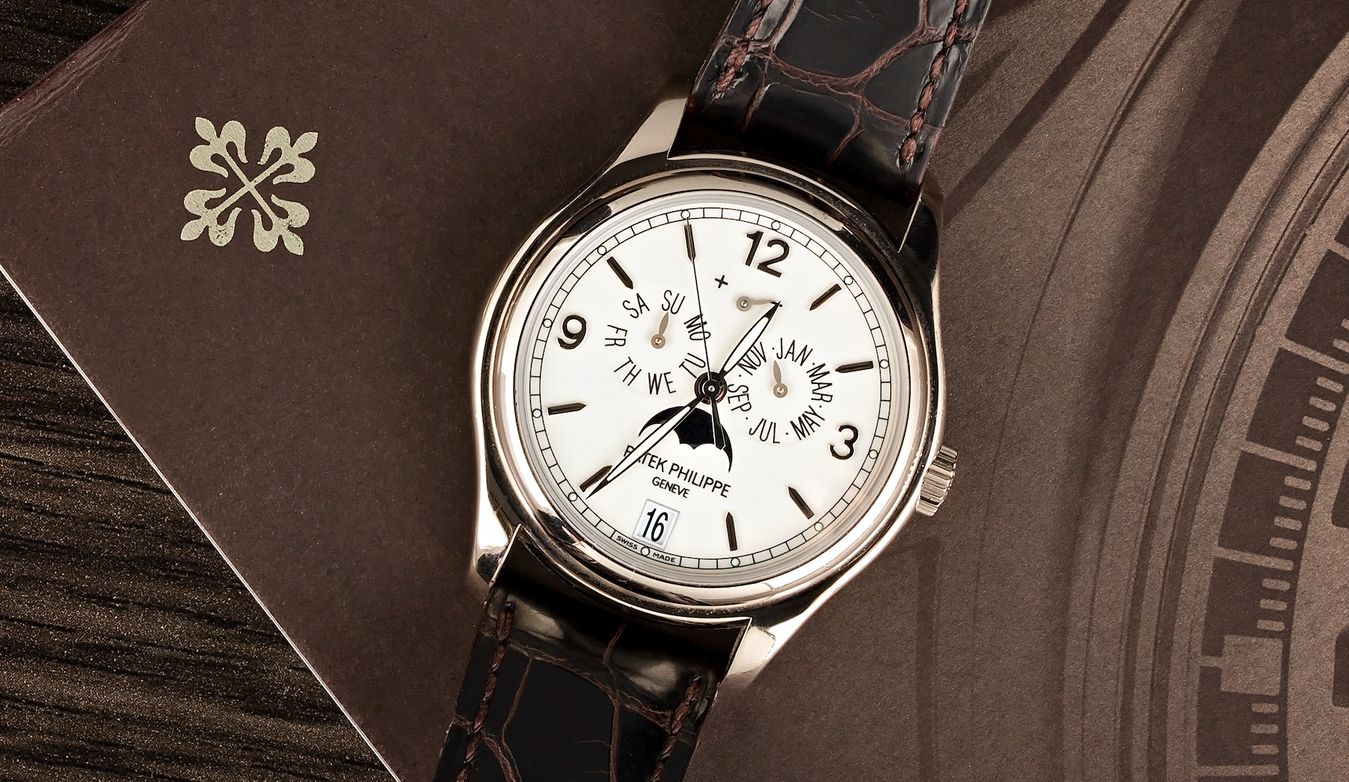Introduced in 1972, the AP Royal Oak was not only a game-changer for Audemars Piguet but also for the entire luxury Swiss watch industry. The debut of the Royal Oak created what we now know as the luxury sports watch category – a genre that remains exceedingly popular today. Like so many other watches that broke away from traditions, the Gerald Genta-designed Royal Oak watch wasn’t an immediate success. However, try to get your hands on one today and it’ll immediately become clear just how sought after the AP Royal Oak watch is. Characterized by its eight-sided bezel punctuated with exposed screws, hobnail dial, and integrated bracelet, the Royal Oak is an iconic watch design.
The Royal Oak celebrated its 50th anniversary in 2022 and has grown from a single reference watch to a massive lineup (and AP’s most important collection) of watches available in a dizzying assortment of sizes, materials, colorways, and complications. With a focus on key references and models, welcome to our ultimate guide to the Audemars Piguet Royal Oak.
AP Royal Oak History

If you’re at all familiar watches – particularly Swiss luxury watches – you would have no doubt have heard of Gerald Genta, who was a prolific watch designer that conceived watches the industry’s biggest brands. Though he passed away in 2011, Genta’s legacy lives on through the watches he conceived including the Universal Genève Polerouter, the Patek Philippe Nautilus, the Bulgari-Bulgari, the Cartier Pasha, and so many others. One of his greatest watch designs turned out to be the Royal Oak for Audemars Piguet.
In an interview he did in 2009, Genta retells the story of how the Royal Oak came to be. According to him, Georges Golay, the Managing Director of Audemars Piguet, called him up and asked for the design of an entirely new waterproof steel sports watch by the next morning. Taking inspiration from antique diving helmets, Genta sketched the sports watch for Audemars Piguet in one night. It had an octagonal bezel with eight hexagonal screws, a simple time and date dial, an integrated bezel, and most importantly, it was to be fashioned entirely in stainless steel.
Audemars Piguet debuted the Royal Oak at the 1972 Basel Fair. Due to its enormous (for the era) 39mm case, avant-garde silhouette, and hefty CHF 3,650 price tag (the most expensive steel watch in the market, by far and even pricier than many gold dress watches at that time), the Royal Oak was too shocking for the market to accept, initially. That first model was the Royal Oak ref. 5402 and thanks to its size, it quickly picked up the nickname “Jumbo.” However, despite the initial resistance, it wasn’t long before the trend picked up and other brands, such as Vacheron Constantin, Girard-Perregaux, and Patek Philippe, offered up their versions of the luxury steel sports watch that same decade.
The Defining Traits of the AP Royal Oak

While there are plenty of variations in the AP Royal Oak collection, the watches (barring a few exceptions) all share the following defining design characteristics.
- Octagonal bezel, which gives the Royal Oak its bold and recognizable look
- Eight hexagonal-shaped screws in the bezel
- A hobnail patterned (also known as Clous de Paris) dial, which the brand calls a Tapisserie dial. There are different sized patterns, classified as Petite Tapisserie, Grande Tapisserie, and Méga Tapisserie
- Integrated bracelet, which transitions seamlessly from the case
It’s also worth pointing out that two letters following Audemars Piguet (all, not just Royal Oaks) reference numbers denote the watch case metal:
- BA – Yellow Gold
- BC – White Gold
- ST – Steel
- OR – Rose Gold
- PT – Platinum
- TI – Titanium
Understanding this shorthand will make reading Royal Oak reference numbers a little easier.
What is the Royal Oak Jumbo?

As previously mentioned, when the maiden Royal Oak ref. 5402 was released, it became known as the Jumbo because of its large 39mm case size. Yet, while 39mm is by no means considered “Jumbo” in today’s watch market, we still hear this term often when discussing Royal Oak watches. So what is a Royal Oak Jumbo?
When collectors and enthusiasts say Royal Oak Jumbo, they are referring to either the original reference 5402ST or to models that were fashioned to honor that reference. These watches have ultra-thin 39mm cases, lack a seconds hand, and run on (except for the newest reference 16202ST) the self-winding Caliber 2121, which is based on the Jaeger-LeCoultre caliber 920.
- Reference 5402ST: Launched in 1972 but made in several series (A-, B-, C-, and D- series)
- Reference 14802 Jubilee: A limited-edition (1,000 examples) Royal Oak produced in 1992 to commemorate the 20th anniversary of the model
- Reference 15002ST: Released in the mid-1990s and by some reports only 186 examples were ever made
- Reference 15202ST: Originally released in 2000 but redesigned in 2012 (to celebrate the 40th anniversary) to look even more like the original Jumbo reference.
- Reference 16202ST: Released in 2022, this is the newest iteration of the original Royal Oak Jumbo with a brand new Caliber 7121 movement with a longer power reserve.
Some of the changes that occurred to the Reference 15202ST in 2012 that made it look closer to the original reference 5402ST included the shift of the AP logo back to the 6 o’clock position (instead of 12 o’clock), the addition of double index markers at 12 o’clock, and a smaller Tapisserie pattern. In 2022, Audemars Piguet replaced the reference 15202ST with the 16202ST, which retains much of the beloved Royal Oak Jumbo design traits that collectors love but benefits from a new-generation in-house Caliber 7121 automatic movement.
Flagship Royal Oak References

- Royal Oak 39mm 15300: 2005 – 2012
- Royal Oak 41mm 15400: 2012 – 2019
- Royal Oak 37mm 15450: 2012 – 2022
- Royal Oak 41mm 15500: 2019 – present
- Royal Oak 37mm 15550: 2022 – present
While some collectors will argue that the Jumbo watches are the only true AP Royal Oak to own, we cannot overlook the modern flagship Royal Oak references. In fact, it could be said that while the cult-classic Jumbo Royal Oaks are exceedingly collectible, the modern “mainstream” Royal Oak references (that are also available in many more materials, dial colors, and strap variations) are what made this particular AP model the powerhouse it is today.
We start with the Royal Oak 15300, which launched in 2005. Although reference 15300 retained the 39mm case size and defined Royal Oak traits, there were some significant changes too. First of all, the overall execution of the Royal Oak 15300 was bolder and weightier owing to the thicker case and more solid bracelet. The thicker case is home to the in-house Caliber 3120 automatic movement, which adds a central seconds hand to the dial. Also notable on the dial of the Royal Oak ref. 15300 is the large AP logo that serves as the 12 o’clock marker.
Audemars Piguet discontinued the Royal Oak 15300 in 2012 and replaced it with two other Caliber 3120-powered flagship models: reference 15400 with 41mm cases and reference 15450 with 37mm cases. The biggest difference on the dials of these Royal Oak references compared to the preceding ref. 15300 was the replacement of the large AP logo at 12 with more traditional double indexes. In 2019, Audemars Piguet replaced the Royal Oak 41mm ref. 15400 with the Royal Oak 41mm ref. 15500, complete with a new Caliber 4302 with improved power reserve and higher frequency. In terms of dial design changes, the big one was the removal of the “Automatic” label at 6 o’clock.
Finally, Audemars Piguet replaced the Royal Oak 37mm 15450 with the updated Royal Oak 37mm 15550, which includes slightly redesigned cases, bracelets, and dials for an overall more minimalist look.
36mm Midsize AP Royal Oak

So far, we’ve only highlighted the larger Royal Oak offerings, spanning from 37mm to 41mm. However, the now-discontinued Royal Oak 36mm watches, which AP defined as midsize, represent an important portion of the history and evolution of the RO so we’ll briefly outline them here.
- Royal Oak 36mm 4100: Introduced 1978
- Royal Oak 36mm 14332: Introduced 1980
- Royal Oak 36mm 14486: introduced 1988
- Royal Oak 36mm 14700: Introduced 1991
- Royal Oak 36mm 14790: Introduced 1992
Audemars Piguet discontinued the 36mm Royal Oak in 2005.
Other AP Royal Oak Models

The Audemars Piguet Royal Oak collection showcases a diverse range of models, each exemplifying the brand’s commitment to innovation and craftsmanship. From the robust Offshore and precise Chronograph to the intricate Skeleton and complex Perpetual Calendar, the line offers something for every connoisseur. The Tourbillon models represent the pinnacle of horological artistry, while the avant-garde Concept Collection pushes boundaries in design and technology. Together, these variants embody the Royal Oak’s enduring legacy of luxury and engineering excellence.
Offshore
The Audemars Piguet Royal Oak Offshore, introduced in 1993, marked a bold evolution of the iconic Royal Oak design. This larger, more robust variant caters to those seeking a sportier aesthetic without compromising on luxury. With its distinctive octagonal bezel, visible gasket, and chunky pushers, the Offshore exudes a powerful presence on the wrist.
Crafted from various materials including stainless steel, titanium, ceramic, and gold, the Offshore collection offers a wide range of styles and complications. From diving models with impressive water resistance to chronographs suitable for timing high-speed events, these timepieces blend functionality with avant-garde design.
The Offshore’s oversized case, typically measuring 42mm or larger, houses intricate movements visible through sapphire casebacks. This line has seen numerous limited editions and collaborations, cementing its status as a favorite among collectors and celebrities alike. The Royal Oak Offshore continues to push boundaries in both technology and design.
Chronograph
The Royal Oak Chronograph seamlessly integrates precision timekeeping into the classic Royal Oak design. This model retains the iconic octagonal bezel and tapisserie dial while incorporating chronograph functions. The addition of subdials and pushers enhances both the watch’s functionality and its visual appeal, creating a harmonious balance between sport and elegance.
Available in various metals and dial colors, the Royal Oak Chronograph offers versatility for different tastes and occasions. The in-house movement, visible through the caseback, showcases Audemars Piguet’s horological expertise. With its ability to measure elapsed time with accuracy, this model is favored by those who appreciate both performance and style.
The Royal Oak Chronograph has evolved over the years, with updates to case sizes, movement calibers, and dial designs. Limited editions and special releases have made this model a sought-after piece for collectors. Whether in its classic steel iteration or more luxurious gold variants, the Royal Oak Chronograph remains a cornerstone of the collection.
Skeleton
The Royal Oak Skeleton represents the pinnacle of horological artistry within the collection. By removing the dial and exposing the intricate movement beneath, Audemars Piguet showcases its mastery of both mechanics and aesthetics. The skeletonized design allows wearers to appreciate the complex interplay of gears, bridges, and springs that power the timepiece.
Crafted with meticulous attention to detail, the skeleton models feature hand-finished components visible through both the front and back of the watch. The exposed movement becomes an integral part of the watch’s visual appeal, with carefully considered architecture that maintains legibility while maximizing transparency. This delicate balance of form and function exemplifies Audemars Piguet’s commitment to innovation.
Available in various metals and often adorned with precious stones, the Royal Oak Skeleton caters to connoisseurs who appreciate the art of watchmaking. Limited production numbers and the high level of craftsmanship required make these models particularly exclusive. The Skeleton variants showcase Audemars Piguet’s ability to push the boundaries of traditional watchmaking while honoring its heritage.
Perpetual Calendar
The Royal Oak Perpetual Calendar stands as a testament to Audemars Piguet’s mastery of complex complications. This sophisticated timepiece accurately displays the day, date, month, year, and moon phase, automatically adjusting for months of varying lengths and leap years. The intricate mechanism requires adjustment only once every 100 years, showcasing the brand’s commitment to precision and longevity.
Despite its complex functionality, the Royal Oak Perpetual Calendar maintains the collection’s signature aesthetic. The information is displayed on the iconic tapisserie dial in a balanced and legible manner, with subdials harmoniously arranged to preserve the watch’s elegant proportions. Available in various materials, from steel to precious metals, this model caters to diverse preferences.
The Perpetual Calendar represents one of the most prestigious complications in horology, and its integration into the Royal Oak line elevates the collection’s status. Limited editions and special releases, often featuring innovative materials or artistic dial treatments, make these models highly coveted among collectors. The Royal Oak Perpetual Calendar embodies the perfect fusion of traditional watchmaking and contemporary design.
Tourbillon
The Royal Oak Tourbillon represents the pinnacle of horological craftsmanship within the collection. This complication, originally designed to counteract the effects of gravity on a watch’s accuracy, serves as a mesmerizing display of mechanical artistry. The tourbillon cage, visible through an aperture on the dial, rotates continuously, showcasing the beating heart of the timepiece.
Audemars Piguet’s rendition of the tourbillon in the Royal Oak line demonstrates the brand’s ability to seamlessly integrate high complications into its iconic design. The tourbillon models often feature skeletonized dials or movements, allowing a comprehensive view of the intricate mechanism. Crafted from premium materials and finished to the highest standards, these watches are true collectors’ items.
Limited production numbers and the exceptional skill required in their creation make Royal Oak Tourbillon models some of the most exclusive in the collection. Variations include flying tourbillons, multi-axis tourbillons, and models combining the tourbillon with other complications. These timepieces not only serve as precision instruments but also as wearable works of art, exemplifying Audemars Piguet’s position at the forefront of haute horlogerie.
Concept Collection
The Royal Oak Concept Collection represents Audemars Piguet’s laboratory for horological innovation. Launched in 2002 to celebrate the Royal Oak’s 30th anniversary, this avant-garde line pushes the boundaries of watchmaking in terms of design, materials, and complications. Concept models often feature futuristic aesthetics combined with cutting-edge technical solutions.
Each Concept watch serves as a platform for experimenting with new ideas, from novel case materials like alacrite and carbon composites to groundbreaking complications such as supersonneries and flying tourbillons. These timepieces often incorporate multiple high complications within a single watch, showcasing Audemars Piguet’s technical prowess and creative vision.
Produced in extremely limited numbers, Royal Oak Concept watches are prized by collectors for their rarity and innovation. While they may seem a departure from the classic Royal Oak design, they maintain core elements like the octagonal bezel and exposed screws. The Concept Collection embodies Audemars Piguet’s commitment to pushing the envelope of what’s possible in luxury watchmaking, setting new standards for the industry.
The Royal Oak Risk Paid Off

It’s clear that Audemars Piguet’s risky bet on the Royal Oak over five decades ago paid off. It’s not an exaggeration to say that the Royal Oak changed the watch industry. Its impact is felt even stronger today, as illustrated by the slew of high-end steel sports watches that dominate the market.
The Royal Oak’s revolutionary design not only inspired other brands to follow suit but also created a blueprint for Audemars Piguet to continuously expand upon, resulting in an immensely varied collection of watches that never stray too far away from that maiden 1972 reference.









